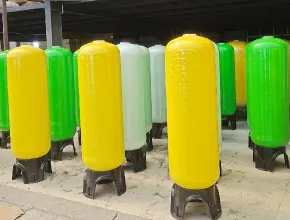loading...
- No. 9, Xingyuan South Street, Dongwaihuan Road, Zaoqiang County, Hengshui, Hebei, China
- admin@zjcomposites.com
- +86 15097380338
- Welcome to visit our website!
Advancements in Glass Fiber Reinforced Polymer Bars for Enhanced Structural Applications
The Advancements and Applications of Glass Fiber Reinforced Polymer Bars
In recent years, the construction and engineering industries have witnessed a significant transformation with the advent of advanced materials. One such notable innovation is the use of Glass Fiber Reinforced Polymer (GFRP) bars. These materials have emerged as a groundbreaking alternative to traditional steel reinforcement bars in concrete structures, offering numerous advantages in performance, durability, and sustainability.
Understanding GFRP Bars
Glass Fiber Reinforced Polymer bars are composite materials made of a polymer matrix reinforced with glass fibers. The integration of glass fibers enhances the mechanical properties of the polymer, resulting in bars that are lightweight yet exceptionally strong. These bars are characterized by their high tensile strength, corrosion resistance, and adaptability to various environmental conditions. This makes them particularly suitable for applications in harsh environments where conventional steel might face challenges such as rust and deterioration.
Key Advantages of GFRP Bars
1. Corrosion Resistance One of the most significant benefits of GFRP bars is their resistance to corrosion. Unlike steel reinforcements that can corrode due to moisture and chemical exposure, GFRP bars remain unaffected by environmental elements. This property significantly extends the lifespan of structures, reducing maintenance costs and enhancing overall sustainability.
2. Lightweight Nature GFRP bars are considerably lighter than traditional steel bars, making them easier to handle, transport, and install. This lightweight characteristic not only reduces the labor intensity of construction projects but also contributes to lower transportation costs and decreased energy consumption during installation.
3. Design Flexibility The application of GFRP bars offers designers greater flexibility in terms of structural design. Their versatility allows for innovative architectural solutions, where traditional materials might pose limitations. Engineers can exploit the unique properties of GFRP to create structures that are not only functional but also aesthetically pleasing.
4. Thermal Insulation GFRP bars exhibit low thermal conductivity, making them an effective thermal insulator. This property can enhance the energy efficiency of buildings, contributing to lower heating and cooling costs over the lifespan of the structure.
glass fiber reinforced polymer bars

5. Non-Magnetic Properties GFRP bars are non-magnetic, which makes them ideal for applications in environments sensitive to electromagnetic interference, such as in MRI rooms in hospitals or in secure facilities where electronic equipment must be protected.
Applications of GFRP Bars
The versatility of GFRP bars has led to their adoption across a wide range of applications. In the construction industry, they are increasingly utilized in bridge construction, particularly in areas needing lightweight and corrosion-resistant materials. Their ability to withstand harsh weather conditions makes them ideal for coastal and marine structures, effectively reducing the risk of structural damage.
In addition, GFRP bars are gaining traction in precast concrete elements, providing robust reinforcement without the associated weight of steel reinforcements. Their use is also prevalent in retrofitting aging structures, where reinforcing existing concrete elements with GFRP can enhance load capacity and extend service life.
Beyond construction, GFRP bars are making an impact in the automotive and aerospace industries, where lightweight materials are crucial for improving fuel efficiency and performance. As the demand for sustainable materials grows, GFRP bars are positioned to play a pivotal role in reducing the carbon footprint of various industries.
Future Prospects and Considerations
As technology advances, the manufacturing processes for GFRP bars are becoming more refined, leading to enhanced material properties and reduced costs. Ongoing research into optimizing fiber and matrix compositions promises to unlock new potential applications and performance characteristics.
Nevertheless, despite their numerous advantages, there are considerations to address when working with GFRP bars. The initial cost of raw materials can be higher compared to traditional steel. However, given their longevity and reduced need for maintenance, the long-term benefits often outweigh the initial investment.
In conclusion, Glass Fiber Reinforced Polymer bars represent a significant advancement in construction materials, offering a range of benefits that enhance durability, sustainability, and design flexibility. As industries continue to embrace innovative solutions, GFRP bars are poised to become a mainstay in construction and beyond, paving the way for a more durable and environmentally friendly future.
-
GRP Structures: The Future of Lightweight, High-Performance EngineeringNewsJun.20,2025
-
FRP Water Tank: High-Performance Storage for Corrosive and Clean Water SystemsNewsJun.20,2025
-
FRP Square Tube: The New Industry Standard for Chemical and Structural ApplicationsNewsJun.20,2025
-
FRP Pultruded Profiles: The Ultimate Choice for Lightweight Structural StrengthNewsJun.20,2025
-
FRP Handrails: The Safer, Smarter, and Stronger Choice for Modern InfrastructureNewsJun.20,2025
-
FRP Grating: The Smart Solution for Durable, Lightweight Industrial FlooringNewsJun.20,2025
-
Why Choose a Galvanized Water Tank for Your Storage NeedsNewsMay.21,2025
